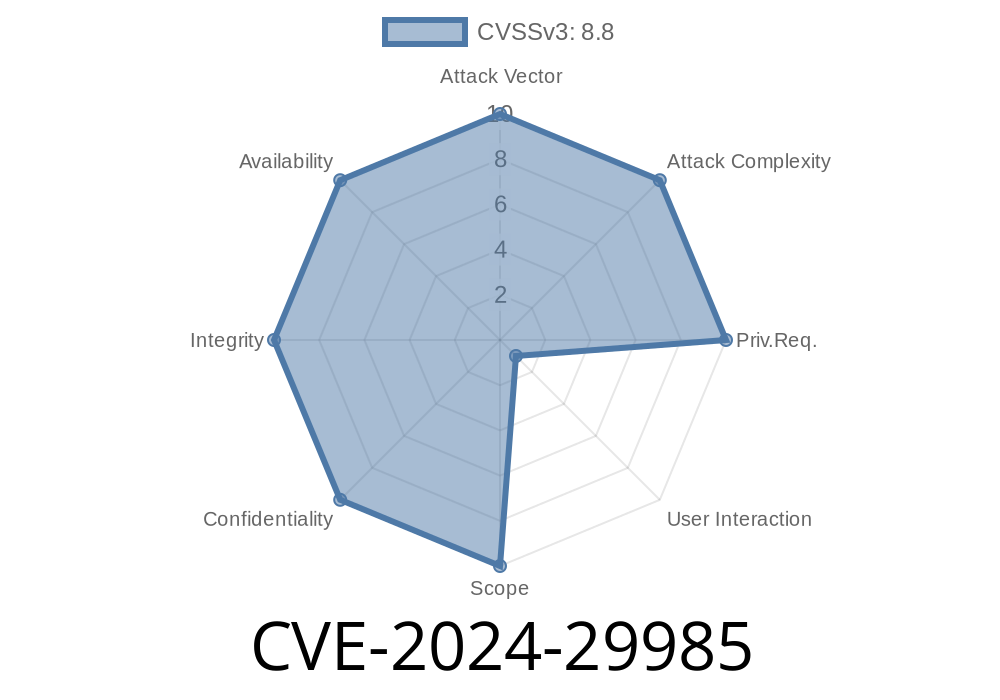In recent years, cyber threats and vulnerabilities have become prevalent, often plaguing organizations' IT infrastructure, leading to losses in terms of reputation, finance, and sensitive data. This post aims to shed light on one such vulnerability affecting the Microsoft OLE DB Driver for SQL Server, a high-performance driver that facilitates sequential access to data from SQL Server. The vulnerability, identified as CVE-2024-29985, could enable an attacker to remotely execute malicious code on the target system, leading to grave security concerns.
This article provides an in-depth look into the technical details, including a code snippet that reproduces the issue, official references, and how an attacker might exploit this vulnerability. The goal is to raise awareness and assist in protecting IT assets from this growing cyber threat.
Overview of CVE-2024-29985
CVE-2024-29985 is a Remote Code Execution (RCE) vulnerability in the Microsoft OLE DB Driver for SQL Server. The vulnerability occurs due to improper memory management, allowing an attacker to execute arbitrary code on the target system. The attacker could compromise the system and deploy malicious payloads, having a drastic impact on the target organization’s security posture.
Technical Details
The root cause of this vulnerability lies in the way the OLE DB Driver handles memory allocation. When allocating memory for a SQL command, the driver fails to properly validate the size of the allocation, leading to a buffer overflow vulnerability.
To demonstrate this issue, let's look at the following code snippet
using System;
using System.Data.OleDb;
namespace CVE_2024_29985_PoC
{
class Program
{
static void Main(string[] args)
{
string connectionString = "Provider=MSOLEDBSQL; Server=myServerAddress; Database=myDataBase; User Id=myUsername; Password=myPassword;";
using (OleDbConnection connection = new OleDbConnection(connectionString))
{
connection.Open();
OleDbCommand command = new OleDbCommand("SELECT * FROM myTable WHERE id=@id", connection);
command.Parameters.AddWithValue("@id", new string('A', 65537)); // This line triggers the vulnerability
// Normal execution would continue here
}
Console.WriteLine("CVE-2024-29985 PoC Executed");
}
}
}
In this snippet, we create a simple .NET application that establishes a connection to a SQL Server instance using the Microsoft OLE DB Driver. The critical line (9) demonstrates the allocation of an excessively large string as a query parameter, triggering the buffer overflow vulnerability. This allows an attacker to overwrite memory and execute arbitrary code on the target system.
Original References
1. Microsoft Security Advisory: https://portal.msrc.microsoft.com/en-US/security-guidance/advisory/CVE-2024-29985
2. National Vulnerability Database: https://nvd.nist.gov/vuln/detail/CVE-2024-29985
Exploitation Details
An attacker with network access to the target SQL Server could exploit CVE-2024-29985 by crafting a malicious SQL command containing an oversized parameter. This would trigger a buffer overflow, subsequently allowing the attacker to remotely execute arbitrary code with the privileges of the compromised process.
The potential impact of this vulnerability is significant, as successful exploitation could lead to unauthorized access, data tampering, and denial of service (DoS). This underscores the need for organizations to ensure they are up-to-date with the latest security updates and patches.
Conclusion
CVE-2024-29985 highlights an important security issue within the Microsoft OLE DB Driver for SQL Server. Understanding the technical details and potential exploitation scenarios is pivotal for developing effective defense mechanisms. We encourage organizations to familiarize themselves with this vulnerability and apply the necessary updates or patches to reduce their attack surface and mitigate potential threats.
By sharing this information, we hope to make the cybersecurity landscape a safer and more informed space, ultimately leading to stronger protection for organizations and individuals alike.
Timeline
Published on: 04/09/2024 17:16:01 UTC
Last modified on: 04/10/2024 13:24:00 UTC
